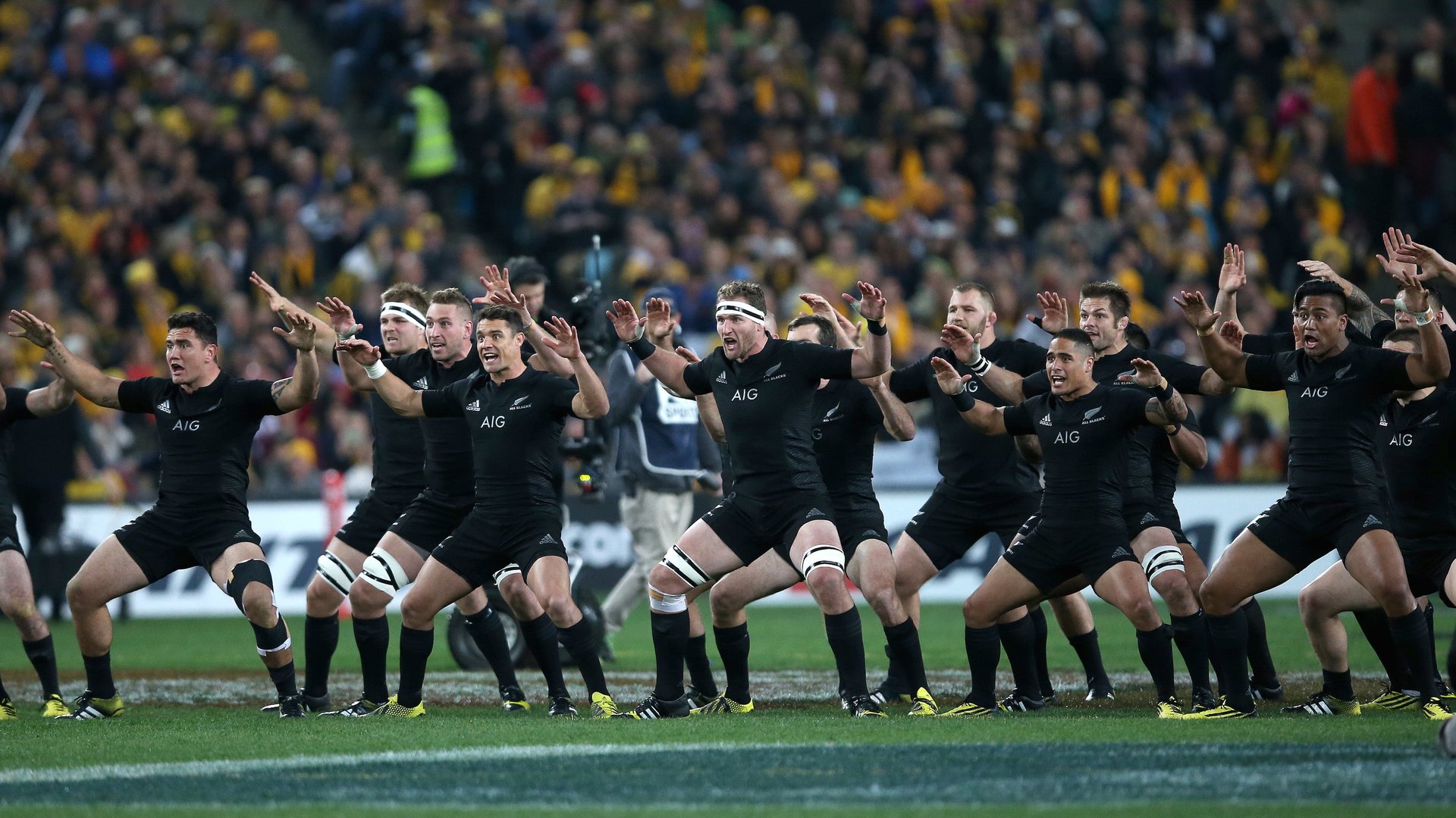New Zealand’s rugby team pays homage to indigenous culture without appropriating it
As Brazil or Italy is to soccer, New Zealand is to rugby. And aside from superior performance on the pitch, the All Blacks—as the national team is known—are perhaps most famous for a special pre-game ritual.


As Brazil or Italy is to soccer, New Zealand is to rugby. And aside from superior performance on the pitch, the All Blacks—as the national team is known—are perhaps most famous for a special pre-game ritual.
Before each match, the All Blacks, who are set to play Namibia on Sep. 24 in the 2015 Rugby World Cup, perform “the haka”—a traditional, full-body dance and accompanying chant derived from Maori culture. (The Maori are New Zealand’s indigenous people.)
Historically, the haka is a ceremonial act intended to welcome visitors to a Maori community. Contemporarily, however, it is performed at all manner of special occasions, including birthdays, weddings, and funerals. In a video that went viral earlier this summer, thousands of students bid farewell to a recently deceased (and much beloved) teacher in the town of Palmerston, by way of the haka:
“Ka Mate,” arguably the most popular haka, was composed in the 1820s by the Maori chieftain Te Rauparaha. It has since been adopted by the All Blacks, who first began performing it before matches in 1905.
As the World Cup unfolds in England, the haka remains an incredible sight to behold. And one that, regardless of one’s national affiliations, is bound to hit you with a rush of adrenaline. The Washington Post’s Ishaan Tharoor describes it as a “perfect act of nationalism.”
I would venture a step further: The All Blacks’ rendition of the haka is indeed a superb act of nationalism, but also a heartening example of postcolonial cohesion. (Rugby has a knack for this.) As Tharoor puts it, “the haka, in its growling intensity, captures … the solidarity of warriors—both of Maori and non-Maori descent—fighting for a common future.”
It’s also an instance of a sports team paying homage to an indigenous culture without simply appropriating it. In this way, the All Blacks stand in stark contrast to controversial US franchises such as the Cleveland Indians, the Washington Redskins, and, sadly, my hometown Chicago Blackhawks—all of which incorporate imagery and nomenclature that offends many Native Americans.
Some argue such branding is intended to “honor” indigenous peoples. How this is accomplished by way of leering, cartoonish likenesses or outright epithets is beyond me. Even if such depictions weren’t constantly flagged as offensive by Native American advocates, slapping the name of a tribe onto your baseball cap is a decidedly superficial way to demonstrate respect.
The All Blacks’ presentation of the haka is inclusive and participatory. It is, from most reports, authentically performed and assiduously studied by Maori and non-Maori players alike. And this signals, more broadly, New Zealand’s relative success at integrating colonial and indigenous societies.
Of course, the treatment of the Maori in New Zealand is by no means been perfect. Nor has it ever been. They have suffered systemic discrimination and disenfranchisement, as have most colonized peoples at some time or another. Large tracts of land were confiscated from them in 1865 following the Taranaki Wars, for example. And as with native populations in the Americas, diseases imported from Europe took a massive toll. Meanwhile, realtors and landlords were permitted to refuse Maori tenants well into the midcentury. A parallel movement to the American Civil Rights Movement sprung up in the 1960s to address such structural inequalities.
Even today, inequality persists. Some critics go so far as to call New Zealanders’ affinity for the haka hypocritical, given that the Maori language and other aspects of the culture are dying out, and generally neglected by national schools.
But, on balance, New Zealand’s relationship with the Maori is, relatively speaking, something to be emulated. The Maori were accorded civil rights comparably earlier than most colonized peoples around the world. They were granted rights as full British subjects and had their property rights recognized with the signing of the Treaty of Waitangi in 1840. This was more than 100 years before the Aboriginal people of Australia were offered full citizenship, and more than 80 years before the Indian Citizenship Act in the United States. Intermarriage was not necessarily looked down upon.
Politically speaking, the Maori have also been quite successful—again, relatively speaking. They were guaranteed four seats in New Zealand’s parliament starting in 1867, which has since grown to seven. As of the 2014 election, representation far surpasses the seven-seat minimum. There are a total of 25 sitting MPs of Maori descent, constituting 21% of the legislature.
When it comes to the political inclusion of indigenous peoples, the US, Canada, and Australia could learn a thing or two from their Kiwi peers. When it comes to paying homage to indigenous cultures in meaningful, respectful ways, the MLB, NFL, and the NHL should also all take note. Because New Zealand and its All Blacks have figured it out.